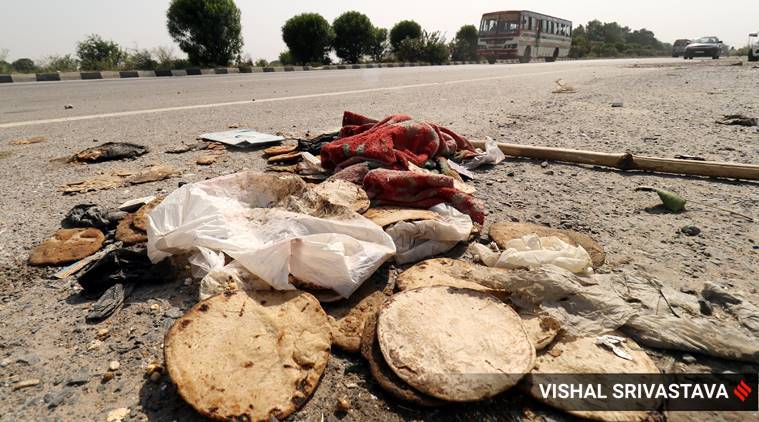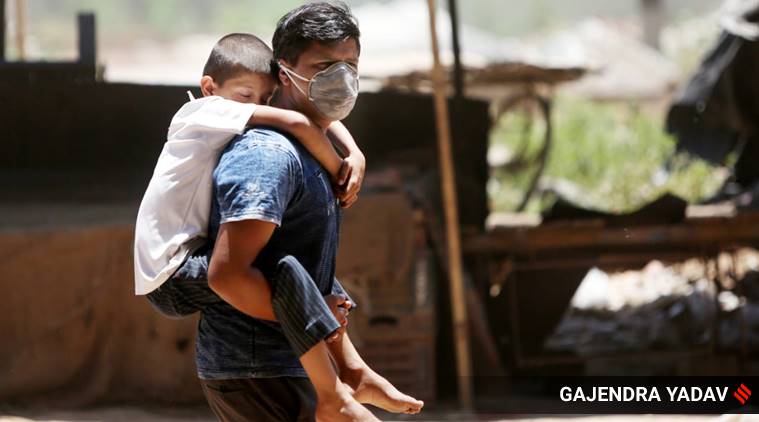 Food being carried by migrants at the site of the accident on NH-24, at Mithauli near Auraiya in Uttar Pradesh, Saturday. (Photo: Vishal Srivastav)
Food being carried by migrants at the site of the accident on NH-24, at Mithauli near Auraiya in Uttar Pradesh, Saturday. (Photo: Vishal Srivastav)
Saturday marked the sixth anniversary of the Modi government’s coming to power but hanging over the celebrations by the party were images of the tragedy in Auraiya and from across the nation. Of hapless migrants on the road with no succour in sight. Pushed by the economic distress in the cities and drawn by the reassurance of safety at home in rural Bihar, UP and Odisha, countless have hit highways across the country.
The BJP launched a social media video, “6 saal, bemisaal”, to highlight the achievements of the government and there is a sense of relief over the national Covid figures. But there is also disquiet in a section of the party and the government, at the Centre and its governments in UP and Bihar, over the lack of anticipation of this crisis which many think will snowball as the stage is set for a further easing of the lockdown.
First, the Centre attempted to shift the blame on to states, especially those ruled by the Opposition – thus, a day after Railway Minister Piyush Goyal accused West Bengal, Jharkhand, Chhattisgarh, and Rajasthan of not allowing Shramik Special trains to bring back migrants, Housing and Urban Affairs Minister Hardeep Singh Puri posted on Twitter on Saturday that “the Auraiya accident. underlines the necessity for stakeholders, including receiving states, to ease restrictions for all affected people, particularly migrants & allow limited air, road & rail connections”.
Prime Minister Narendra Modi described the tragedy as extremely sad. In a message posted on Twitter, he expressed sympathy for the families of the dead, and wished the injured a speedy recovery. Home Minister Amit Shah tweeted a similar message of sympathy and condolence.
Days into the first phase of the lockdown, the Central government had told the Supreme Court that nearly 14.3 lakh people had been housed in 37,978 relief camps, and that an additional 26,225 food camps had been opened to provide food to 1.3 crore people. Nearly 16.5 lakh workers had been given shelter and food by their employers, the government had said.
However, the streams of migrants on the road nearly two months after the lockdown began on March 24, underlines the government’s underestimation of the scale of the disruption that its decision, announced by the Prime Minister with barely four hours’ notice, would trigger.
The deaths of migrants walking, cycling, or travelling packed together in the back of trucks hundreds of kilometres to their villages with their children and belongings, have thrown into sharp relief the extent of both their desperation and the government’s misreading of the impact of an extended lockdown.
With the deaths in Auraiya, the number of migrant workers killed on the roads in the last 54 days has reached 134. The majority of these deaths have occurred in the third phase of the lockdown that began on May 4.
मोदी सरकार के 6 साल…बेमिसाल pic.twitter.com/1fo9M6exft
— BJP (@BJP4India) May 16, 2020
Since May 6, at least 96 migrants have been killed in 19 different incidents on the roads and railway tracks, news reports show.
Struggling to get a correct measure of the economic distress, the central government has been fumbling in its handling of the migrant crisis.
In the last week of March, the Centre wanted states to strictly implement the lockdown, and asked them to seal their borders to ensure migrants did not attempt to walk to their homes. A month later, however, the Home Ministry allowed the movement of stranded migrants beginning May 4.
The government also announced the Shramik Specials, and the first train left from Telangana for Jharkhand on May 1. On Friday, Home Secretary Ajay Bhalla wrote to states asking them to ensure that migrant workers did not walk on the highways, and instead took the Shramik trains home.
Until Friday, close to 1,000 Shramik Specials had ferried over 10 lakh migrants around the country. But that seemingly large number is still a drop in the ocean – the Economic Survey of India 2016-17 estimated the size of the migrant workforce in the country at over 10 crore.
 Migrants walking towards the Dadri Railway station
Migrants walking towards the Dadri Railway station
For the government, a specific concern has been that most of the migrants have been seeking to move out from the Red zones of the big cities to the Green zones of their towns and villages, where the case load of the pandemic continues to be low. Allowing them to travel would increase the risk of the virus spreading, and threaten the already fragile health infrastructure of some of India’s poorest states.
BJP leaders from states conceded the enormity of the migrant crisis. Several of these leaders expressed concern that the “intensity” of the crisis may not have been entirely revealed yet.
A leader in Bihar, where the BJP and its ally JD-U face Assembly elections later this year, said: “Nothing that we have done so far seems to be enough in the face of the enormity of this challenge. We are in power both at the Centre and in the state, and we could become an easy target for the people’s anger.”
K C Tyagi of the JD-U said: “It is unprecedented. The government is trying to handle the situation with the resources that it has. As of now, we not thinking about the election.”
A BJP leader in Madhya Pradesh said that at one point on the state’s border with Maharashtra, the party has been distributing 150 kg of khichdi to the migrants walking in every day.
The BJP has set up community kitchens and helplines, and has been providing medical assistance, dry rations, masks, and hand sanitisers across the country.
On Thursday, party president J P Nadda met his general secretaries in a video conference. The party leadership has asked its workers to distribute food, water, and footwear, and organise day shelters and ambulance services every 100-150 km on the highways.
On Saturday, Nadda posted on Twitter that he was distressed by the death of the migrant workers in Auraiya. He asked BJP workers to help the administration in relief work, and expressed his condolences and sympathy for the dead and injured.